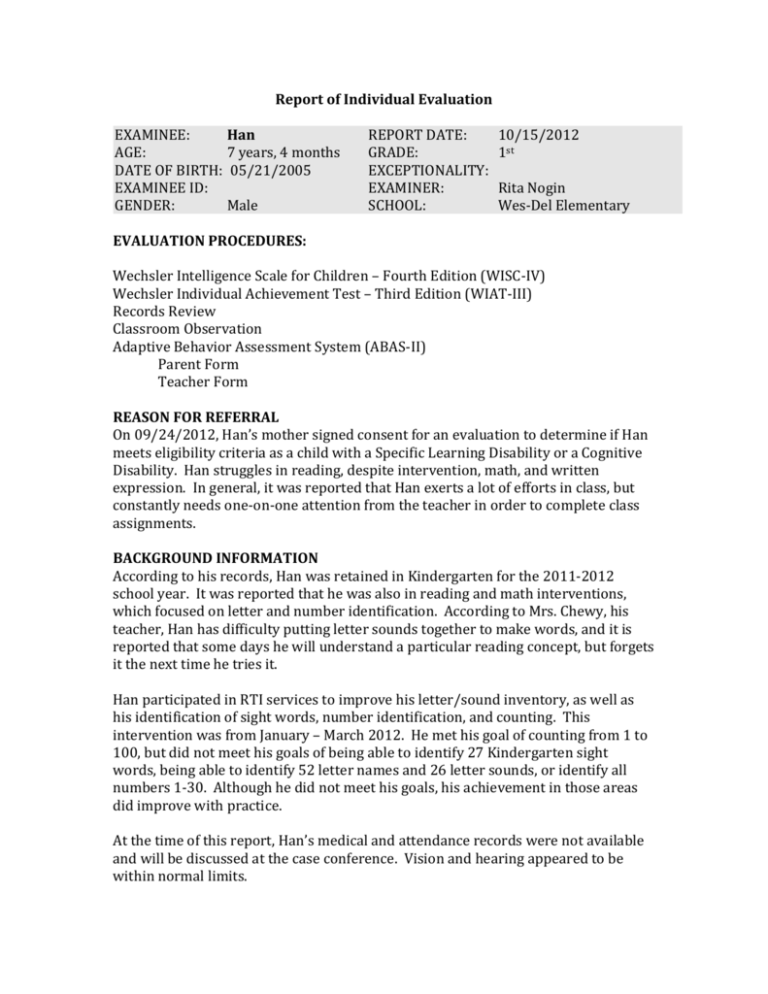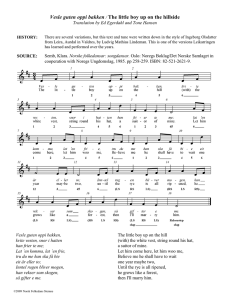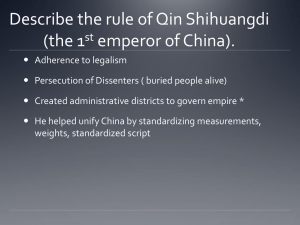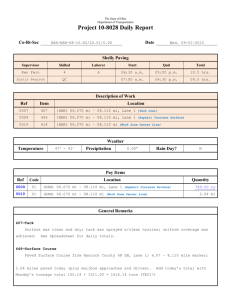2013 Artifact: Report
advertisement

Report of Individual Evaluation EXAMINEE: Han AGE: 7 years, 4 months DATE OF BIRTH: 05/21/2005 EXAMINEE ID: GENDER: Male REPORT DATE: GRADE: EXCEPTIONALITY: EXAMINER: SCHOOL: 10/15/2012 1st Rita Nogin Wes-Del Elementary EVALUATION PROCEDURES: Wechsler Intelligence Scale for Children – Fourth Edition (WISC-IV) Wechsler Individual Achievement Test – Third Edition (WIAT-III) Records Review Classroom Observation Adaptive Behavior Assessment System (ABAS-II) Parent Form Teacher Form REASON FOR REFERRAL On 09/24/2012, Han’s mother signed consent for an evaluation to determine if Han meets eligibility criteria as a child with a Specific Learning Disability or a Cognitive Disability. Han struggles in reading, despite intervention, math, and written expression. In general, it was reported that Han exerts a lot of efforts in class, but constantly needs one-on-one attention from the teacher in order to complete class assignments. BACKGROUND INFORMATION According to his records, Han was retained in Kindergarten for the 2011-2012 school year. It was reported that he was also in reading and math interventions, which focused on letter and number identification. According to Mrs. Chewy, his teacher, Han has difficulty putting letter sounds together to make words, and it is reported that some days he will understand a particular reading concept, but forgets it the next time he tries it. Han participated in RTI services to improve his letter/sound inventory, as well as his identification of sight words, number identification, and counting. This intervention was from January – March 2012. He met his goal of counting from 1 to 100, but did not meet his goals of being able to identify 27 Kindergarten sight words, being able to identify 52 letter names and 26 letter sounds, or identify all numbers 1-30. Although he did not meet his goals, his achievement in those areas did improve with practice. At the time of this report, Han’s medical and attendance records were not available and will be discussed at the case conference. Vision and hearing appeared to be within normal limits. School Enrollment/Attendance History Year Grade School Attended 2012-2013 1st Wes-Del 2011-2012 K Wes-Del DIBELS History Grade Composite K BOY Yellow K MOY Red K EOY Red 1st BOY Red FSF ----- LNF ---23 Days Absent 20.5 3 Tardy Count 6 1 PSF ---21/40 RTI Intervention Data (1/23/2012-3/19/2012) Assessment Letter ID; Sight Words Data: Sound ID Baseline 43/52 4/7 (list 1) 12/26 0/10 (list 2) 2/20/12 46/52 4/7 (list 1) 5/26 2/10 (list 2) 3/05/2012 49/52 7/7 (list 1) 17/26 4/10 (list 2) 3/19/2012 48/52 6/7 (list 1) 22/26 6/10 (list 2) Goal Met? No No Unexcused Absences 18 3 NWF ---1/27 ORF ---0/1 Counting Number ID 1 to 12 1 to 12 1 to 38 1 to 19 1 to 100 1 to 11 1 to 100 1 to 13 Yes No CLASSROOM OBSERVATION Han was observed on 9/25/2012, for 1 hour. He was observed during math, language arts, classwork, and a transition to lunch. It appeared that Han was paying attention and following the directions to the best of his ability. Mrs. Chewy had to repeat directions to him multiple times, and it seemed to take him longer than other students to follow directions (i.e. taking out and opening a folder, what to write on the homework paper). During transition times, it appeared that Han was not paying attention to Mrs. Chewy and had his head on his desk or was wandering around the room instead of getting ready for the next activity. Han appeared to get along with his classmates throughout the observation period. During the transition period, Han was observed talking to some classmates in line. During a lesson, it was observed that Han was paying close attention and attempting the classwork. He participated with the class on number counting, and raised his hand to answer a question during the math lesson. Most of the time during lessons, Han was quietly doing his work, and not really participating in answering questions. During class assignments, Mrs. Chewy was usually assisting him throughout the duration of the assignment. TEST OBSERVATIONS Han was picked up from class by the examiner. He was very quiet but seemed willing to work. He gave good effort throughout the testing session, and tried to persevere through harder items. When he came to items he did not know at all, such as harder reading and spelling items, he said that he did not know them so we moved on. His attention and concentration were typical, as was his ability to sustain attention. He was cooperative and responded well to verbal praise, becoming more comfortable and talkative during the testing session. It is the opinion of the examiner that the test results appear to be an accurate reflection of Han’s current levels of functioning. TEST RESULTS Cognitive Ability Han’s estimated cognitive ability, as measured by the Wechsler Intelligence Scale for Children – Fourth Edition (WISC-IV), fell in the Borderline range (FSIQ = 72) at the 3rd percentile. Han’s verbal reasoning abilities, as measured by the Verbal Comprehension Index, fell in the Borderline range (VCI = 79), and he performed better than 8% of his same-aged peers. The VCI is designed to measure verbal reasoning and concept formation. The Perceptual Reasoning Index is designed to measure fluid reasoning in the perceptual domain with tasks that primarily assess nonverbal fluid reasoning and perceptual organization abilities. Han’s nonverbal reasoning abilities, as measured by the PRI, were varied, so the composite for this group of subtests cannot be interpreted. Instead, it would be more beneficial to look at each subtest individually. Han’s score on items requiring him to manipulate blocks to match a design fell in the Average range (Block Design = 10), as well as his performance on tasks requiring him to determine which picture best fit the group (Matrix Reasoning = 9). However, performance on the Picture Concepts subtest (Picture Concepts = 3) was Very Poor. When the visual stimulus changed from two to three options per row to choose from, Han seemed more confused and started choosing two options from the same row, which led to the significantly lowered score on that particular subtest. Han’s ability to sustain attention, concentrate, and exert mental control on simple tasks was in the Borderline range (Working Memory Index = 77), and he performed better than 6% of his same-aged peers. When asked to process simple or routine visual material without making errors fell in the Borderline range (Processing Speed Index = 70). It is expected that Han would have difficulty processing information as quickly as his peers, and therefore it may take him longer to understand and complete directions and tasks. Academic Achievement The Wechsler Individual Achievement Test-Third Edition (WIAT-III) is an individually administered, norm-referenced test for measuring academic achievement. Han’s performance was compared to the average performance of same-aged peers. Han’s overall academic skills are in the Extremely Low range (Total Achievement = 63). Han was not able to meet the basal requirements for 6 of the 15 subtests. The subtests he was not able to complete involved reading or writing, which he indicated that he could not do. Testing indicated that Han could identify letters, but could not read, and was only able to write his name. Oral Language Han’s overall oral language skills fell within the Borderline range (Oral Language = 77). Han performed in the Borderline range on tasks requiring him to describe pictures (Receptive Vocabulary = 76), and in the Low Average range on tasks requiring him to answer questions based on a story he heard (Oral Discourse Comprehension = 85). Han is expected to perform on a level lower than the majority of his peers for skills requiring expressive and receptive skills. Han’s overall oral language skills are commensurate with his processing speed performance as well as overall cognitive ability. Han’s oral language performance was lower than his performance on verbal comprehension, perceptual reasoning, and working memory indices. Written Language The Written Language composite measures the ability to compose sentences and essays using proper grammar and sentence structure. Han’s overall written language skills fell in the Extremely Low range (Written Expression = 58). He never met the basal point for the Written Expression tasks, with the exception of Alphabet Writing. This indicates that his writing skills are very low for a child his age. Han’s teacher, Mrs. Chewy, reported that his writing skills in class are very low, and when he writes, he is usually copying off the board and not able to generate his own written material. Han’s written language skills are significantly lower than his cognitive abilities. Reading Han’s overall reading skills fell in the Extremely Low range as well (Total Reading = 65). As with the written language subtests, Han was not able to get a basal score for any of the reading subtests, indicating that his reading abilities are lower than most of his same-aged peers. His reading abilities are also much lower than expected, given his overall cognitive abilities. Mathematics Han’s overall mathematics abilities fell in the Low Average range (Mathematics = 80). On tasks requiring him to solve mathematical word problems, Han performed in the Low Average range (Math Problem Solving = 82). On tasks requiring Han to solve math calculation problems, he performed in the Low Average range as well (Numerical Operations = 80). Given Han’s mathematics skills, it is expected that he will struggle a bit more when compared to his peers. Han’s mathematical abilities are a relative strength. Mathematical fluency items required Han to complete simple addition and subtraction problems in the span of 1 minute. Han performed in the Borderline range on timed addition tasks (Addition = 75), and in the Extremely Low range on subtraction tasks (Subtraction = 67). This indicates that he has difficulty with his subtraction facts, as well as with timed tasks. Adaptive Functioning Adaptive functioning information was provided with the Adaptive Behavior Assessment System – Second Edition (ABAS-II) by Han’s mother and teacher. In the school setting, Han is rated as functioning in the Below Average range for adaptive skills. In the home setting, Han is rated as functioning in the Extremely Low range for adaptive skills. In the school setting, Han was rated in the Below Average range in Conceptual skill areas, which are comprised of Communication, Functional Academics, and Self-Direction. In the classroom, it was observed that Han did not communicate very much with the teacher or other classmates during the lesson, but was social with students during transition periods. Self-direction was rated as a relative strength for Han. In the home setting, Han was rated in the Extremely Low range for Conceptual skill areas. In the school, Han was rated in the Average range for social adaptive behavior, and in the Borderline range in the home setting. The Social composite rating was the highest in the school setting. In Practical skill areas, including Community Use, School Living, Home Living, Health and Safety, and SelfCare, Han was rated in the Below Average range across settings. The Practical composite was highest rated score in the home setting. Han’s mother indicated Home Living to be a weakness for Han, whereas School Living was rated very highly by Mrs. Chewy. SUMMARY Han was referred for a Specific Learning Disability and Cognitive Disability evaluation. Han was previously retained in Kindergarten and is now in 1st grade. Last year, during intervention, he was able to increase his counting to 100, but did not meet his goals for letter and sound identification, sight word reading, or number identification. His teacher, Mrs. Chewy, reported that Han needs a great deal of individualized attention in class, which was confirmed during the classroom observation. Han’s cognitive abilities range from the Borderline to Below Average range. His total achievement was in the Extremely Low range, due to his low abilities in reading and written expression. However, Han exhibited personal strengths in math calculation and oral expression. Although Han’s cognitive functioning was in the Borderline range, it was still within two standard deviations from the mean. Han’s current academic achievement is between Extremely Low and Low Average range. He has a pattern of strengths in nonverbal tasks such as Block Design and Matrix Reasoning, as well as in Math Calculation. Han has weaknesses in verbal and fluency tasks, as evidenced by his scores on the Working Memory and Processing Speed indices, as well as his low fluency scores on Addition and Subtraction. According to the ABAS-II, Han was rated in the Below Average range in the school setting, and in the Extremely Low setting in the home setting. The Social composite was the highest overall in the school setting, and the Practical composite was the highest in the home setting. Han demonstrates a pattern of strengths and weaknesses in academic achievement, with regards to his difficulty with verbal information. His cognitive abilities were overall Borderline, with variability within composites and subtests. From classroom observations and teacher report, academic difficulties do not appear to stem from an emotional disability. Currently, there are no medical or attendance records to further ascertain whether Han meets criteria for a Specific Learning Disability, so that will be discussed at the case conference. RECOMMENDATIONS 1. Since Han has a relative strength in understanding and processing nonverbal information, more visual methods of organizing information may be beneficial. Graphic organizers for reading comprehension and writing Counters for math 2. Given Han’s weaknesses in reading, scaffolding may be a better approach to help Han with his reading skills. Scaffolding can help tie in new information with the letter names and sounds that he already knows. Since basal levels were not established for the reading and writing items, the instructional level will most likely be lower than the grade level expectations. It is therefore important for Han to overlearn the information once the instructional level has been established. Test Results Wechsler Intelligence Scale for Children – Fourth Edition (WISC-IV) Scale Composite Percentile 95% Qualitative Score Rank Confidence Description Level Verbal 79 8 73-87 Borderline Comprehension Similarities 8 Average Vocabulary 5 Below Average Comprehension 6 Below Average Perceptual Reasoning Block Design Picture Concepts Matrix Reasoning Working Memory Digit Span Letter-Number Seq. Processing Speed Coding Symbol Search Full Scale IQ (FSIQ) 84 10 3 9 77 5 7 70 3 6 72 14 78-93 6 71-86 2 65-83 3 68-78 Wechsler Individual Achievement Test-III (WIAT-III) Scale Composite Percentile 95% Score Rank Confidence Level Oral Language 73 4 64-82 Listening 77 65-89 Comprehension Oral Expression 75 64-86 Total Reading 65 *Reading 49 Comprehension *Word Reading 59 *Pseudoword Decoding 69 *Oral Reading Fluency 40 Written Expression 58 0.3 50-66 Alphabet Writing 67 Fluency *Sentence Composition 69 *Spelling 48 Mathematics 80 9 73-87 Math Problem Solving 82 Numerical Operations 80 Math Fluency 63 Addition 75 Subtraction 67 *Did not meet basal Low Average Average Very Poor Average Borderline Below Average Below Average Borderline Very Poor Below Average Borderline Qualitative Description Borderline Borderline Borderline Extremely Low Extremely Low Extremely Low Extremely Low Extremely Low Extremely Low Extremely Low Extremely Low Extremely Low Low Average Low Average Low Average Extremely Low Borderline Extremely Low Adaptive Behavior Assessment System – Second Edition (ABAS-II) Composite PARENT PARENT TEACH TEACHER Score/ Qualitative ER Qualitative Scaled Range Score/ Range Score Scaled GAC Conceptual Communication Functional Academics Self-Direction Social Leisure Social Practical Community Use Home Living/School Living Health and Safety Self-Care 66 59 1 3 2 72 3 6 80 9 1 9 5 Extremely Low Extremely Low Borderline Below Average Score 85 84 3 5 10 92 8 9 88 4 8 8 9 Below Average Below Average Average Below Average








